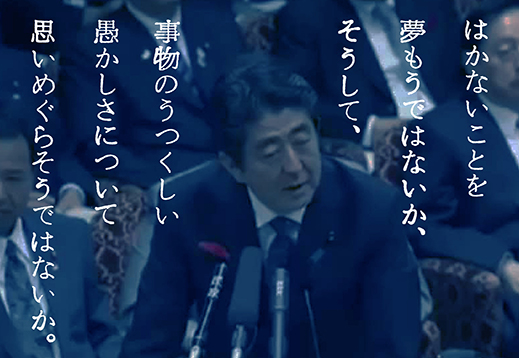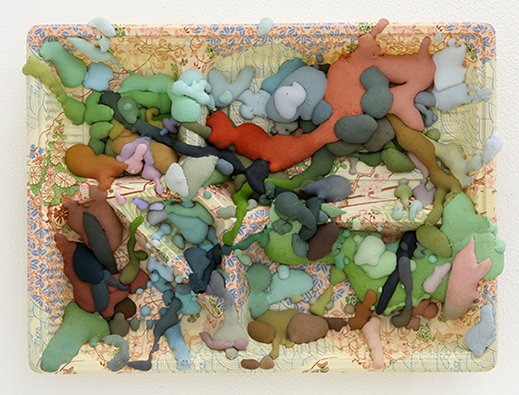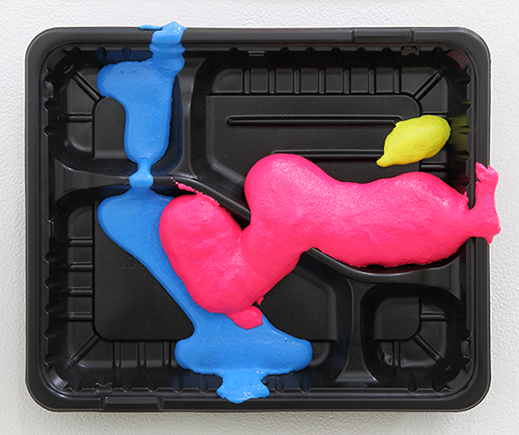 |
Focus features two in-depth reviews each month of fine art, architecture and design exhibitions and events at art museums, galleries and alternative spaces around Japan. The contributors are non-Japanese art critics living in Japan. |
|
|
 |
 |
 |
Of Tempests in Teacups and Brushstrokes in Bento Boxes: Makoto Aida at Mizuma Art Gallery
Susan Rogers Chikuba |
 |
 |
|
"Let us dream of evanescence, and linger in the beautiful foolishness of things." -- Kakuzo Okakura, The Book of Tea |
The announcement for Makoto Aida's solo show at Mizuma Art Gallery was alluring enough -- the always provocative conceptual artist, now 50, would take on "a completely new set of techniques, forms and materials," he didn't mind if the result prompted fans and detractors to swap places, and there would be a media blackout on all images until the exhibition opened. The one photo provided, of Prime Minister Shinzo Abe, was superimposed with a literary quote: "Let us dream of evanescence, and linger in the beautiful foolishness of things."
The meme seemed to be taking its own advice by poking fun at Aida's last satirical foray, covered by Artscape here, when his video installation lampooning the prime minister brewed up trouble. The words, which Aida has adopted for the title of his current exhibition at Mizuma, are from Kakuzo Okakura's The Book of Tea, a 1906 classic published shortly after the end of the Russo-Japanese War. In the opening chapter, "The Cup of Humanity," Okakura lays out the "sordid facts of everyday existence" in a world beset by egotism and vulgarity. (It should sound familiar.) He then launches into his seminal treatise on tea as a work of art with this statement about beautiful foolishness.
 |
|
From the Lunchbox Paintings series by Makoto Aida, 2016; disposable lunchbox, urethane foam, acrylic gouache. Photography by Kei Miyajima. © Makoto Aida, courtesy of Mizuma Art Gallery |
Okakura's argument for seeking the big picture not through the lens of history, society or nation-state, but rather through the more subtle means of appreciating a cup of tea, an arrangement of flowers, or a painting is, says Aida, the inspiration for the Lunchbox Paintings series he premieres at this show. To borrow Okakura's words, ". . . when we consider how small after all the cup of human enjoyment is, how soon overflowed with tears, how easily drained to the dregs in our quenchless thirst for infinity, we shall not blame ourselves for making so much of the tea-cup. Mankind has done worse."
 |
|
From the Lunchbox Paintings series by Makoto Aida, 2016; disposable lunchbox, urethane foam, acrylic gouache. Photography by Kei Miyajima. © Makoto Aida, courtesy of Mizuma Art Gallery |
Enter Aida, to take an idea and play with it. His canvas is the ready-made plastic bento tray, onto which he has dropped meaningless colorful blobs of urethane foam painted to a matte finish with Turner Acryl Gouache, a product line he chose as much for its wealth of traditional Japanese colors as for its hobbyist appeal. With 54 of these on display, the effect is Okakura's "utmost beatitude of the mundane" on overdrive. Aida says he completed all of the works in a space less than the size of two tatami mats, in a corner of his living room. Call it bentoism, in response to Okakura's teaism.
 |
|
From the Lunchbox Paintings series by Makoto Aida, 2016; disposable lunchbox, urethane foam, acrylic gouache. Photography by Kei Miyajima. © Makoto Aida, courtesy of Mizuma Art Gallery |
As if to please the press and pundits who are always seeking out deeper meanings, Aida's statement for the series, provided at the gallery, offers nine bullet points explaining his views on why the living room matters and other story lines, such as the artists whose works he referenced -- Jackson Pollock for drips and drops "heavily reliant on gravity and chance"; Jeff Koons and Damien Hirst for the "kitsch visual aesthetic, a stance as if having hoodwinked the art market." Discerning which points are serious and which are tongue-in-cheek is part of the fun. My guess is that they all have elements of both -- Okakura himself said teaism is Taoism in disguise, and "truth can be reached only through the comprehension of opposites."
Mizuma Art Gallery curators say the exhibition generated the biggest turnout they have ever seen on opening day. |
Aida also obligingly relates his first artistic experience with a bento tray, an item that found its way into his exhibit at the 2001 Yokohama Triennale. After eating the lunch provided him during installation, he stared at the empty container and saw in its different-sized partitions within the four-sided frame something like a Mondrian. He washed the tray and put it on the wall.
If Okakura's tea ceremony is "a sacred function at which the host and guest [join] to produce for that occasion the utmost beatitude of the mundane," then Aida's solo show, though profane and non-interactive, is also "a worship of the Imperfect, as it is a tender attempt to accomplish something possible in this impossible thing we know as life."
From the Lunchbox Paintings series by Makoto Aida, 2016; disposable lunchbox, urethane foam, acrylic gouache. Photography by Kei Miyajima. © Makoto Aida, courtesy of Mizuma Art Gallery
|
All images are by permission of Mizuma Art Gallery. |
 |
 |
Susan Rogers Chikuba
Susan Rogers Chikuba, a Tokyo-based writer, editor and translator, has been following popular culture, architecture and design in Japan for three decades. She covers the country's travel, art, literary and culinary scenes for domestic and international publications. |
|
 |
|